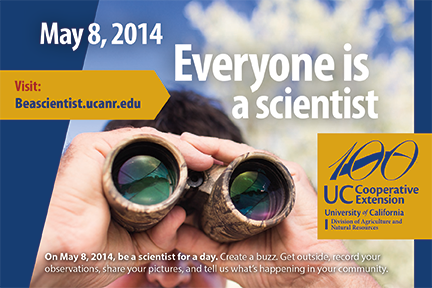
Posts Tagged: colony collapse disorder
Colony collapse disorder: still with us?
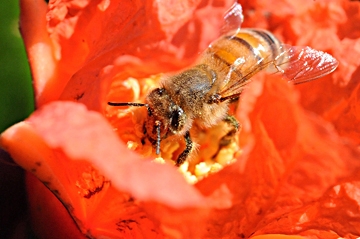
"Does colony collapse disorder (CCD) still exist?"
Eric Mussen, UC Cooperative Extension specialist in the Department of Entomology and Nematology at UC Davis says "yes."
But the winter losses are being attributed to many other causes. "Less than 10 percent of the losses are now attributed to CCD," Mussen points out.
CCD surfaced in the fall of 2006 when beekeepers starting seeing their colonies decimated. They'd open the hive, only to find the queen, the brood and the food stores. The adult workers? Gone.
"CCD still exists and it appears as though in cases where multiple other stresses combine to severely weaken the bees, then viruses can overwhelm the immune system and the bees fly away and die," Mussen says. "We do not know what causes apparently-sick bees to fly from the hive, and we still have a difficult time describing how all the bees could become affected so swiftly."
"As colony losses mounted, the beekeepers had to spend even more time monitoring the conditions of their colonies. They noted things that might be done to prevent some problems that seemed to be starting. So, we are better at preventing the losses, but the percentage for about 25 percent of our beekeepers is still way too high."
Mussen says that "the other 75 percent of the beekeepers are doing relatively well (5-15 percent losses), so we have leveled off in national colony numbers. If the 25 percent can better determine what is going wrong, we should see improved data in the future."
Scientists attribute CCD to a combination of causes, including pests, pesticides, viruses, diseases, malnutrition, and stress. The No. 1 problem in the hives, they agree, is the varroa mite. Mussen writes about those topics - and others in his newsletter, from the UC Apiaries and "Bee Briefs." Both are available free on his website.
Mussen, who is retiring in June after 38 years of service, was recently named the recipient of the 2013-14 Distinguished Service Award, sponsored by the UC Division of Agriculture and Natural Resources.
Mussen devotes his research and extension activities toward the improvement of honey bee health and honey bee colony management practices. Mussen, who joined the UC Davis department in 1976, is known throughout the state, nation and world as “the honey bee guru” and “the pulse of the bee industry" and as "the go-to person" when consumers, scientists, researchers, students and the news media have questions about honey bees.
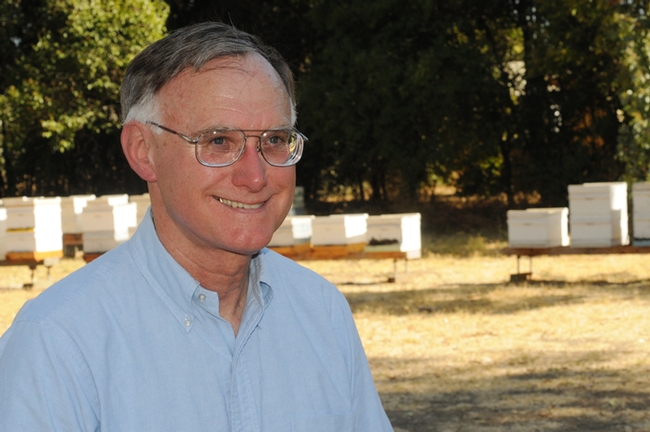
Extension apiculturist Eric Mussen in front of the apiary at the Harry H. Laidlaw Jr. Honey Bee Research Facility at UC Davis. (Photo by Kathy Keatley Garvey)
Pollinators in trouble
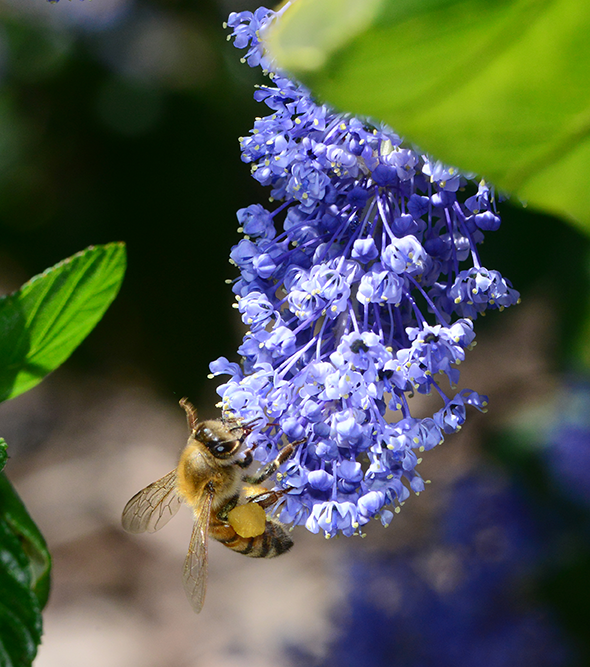
“I'll be holding a precious resource in my hands, one that is essential to life on earth,” says Allen-Diaz. “I'll be placing my hands in Norm's hands to raise awareness about the value of honeybees.”
While raising money for education is certainly a worthy goal, as Allen-Diaz says, the event also draws attention to the plight of our most important agricultural pollinator. In 2006, a number of beekeepers in the Western U.S. noticed their hives had lost 30 to 70 percent of their worker bees. The phenomenon, now known as colony collapse disorder (CCD), is still not fully understood, though a number of factors are believed to be involved. They include habitat loss or degradation and fragmentation, poor nutrition, certain bee management and agricultural practices, natural and chemical toxins, diseases, and parasites. Any one of these factors can affect the insects' ability to combat any of the others. Isolating a single cause, if there is one, has proved elusive.
Many of the fruits and vegetables on the tables of the world are pollinated by insects, particularly bees, and if they were to disappear, our sources of plant food would be restricted to grains and not too much else. It's no wonder CCD is such a concern (for example, see the United Nations Environmental Program 2010 report on Global Bee Colony Disorder and USDA, Honey Bees and Colony Collapse Disorder.
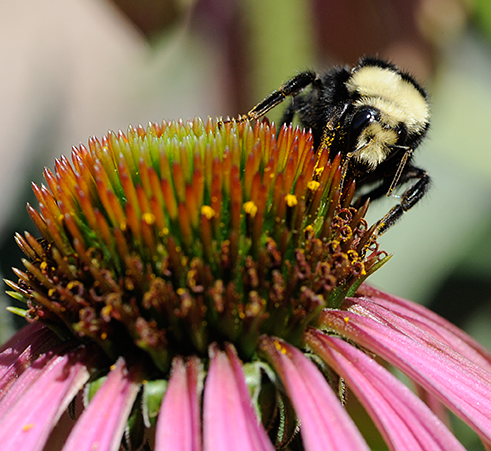
As human population grows and becomes more urban, and as habitats get more fragmented, it is no longer adequate to focus conservation efforts merely in non-urban, non-working landscapes.
“We need to figure out how to accommodate as many native species as possible in these kinds of places,” says Patrick Huber of the City of Davis Open Space and Habitat Commission, which has adopted pollinator habitat enhancement as a working goal. The Commission is working to compile a GIS dataset of known big patches of habitat in Davis, in order map pollinator resources around town.
Huber is a geographer in the Landscape Analysis and Systems Research lab at UC Davis, where he focuses on spatial scale in conservation planning. He is working on a tool to help match gardeners with plants that will grow well in their regions, that are locally available, and that provide a network of resources for pollinators throughout the urban landscape and on into the agricultural landscape. For the moment this project is being piloted in Davis, but the hope is to expand it to other communities, tying in resources such as CalFlora.
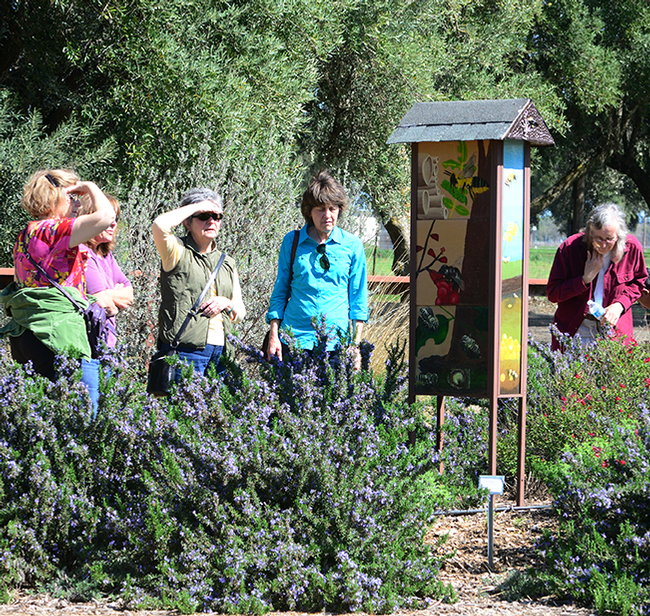
- Planning for succession blooming (in the Central Valley, that means late winter through fall)
- Putting plants in clumps at least 4 feet long if possible (honeybees, especially, like to specialize)
- Putting in plants that provide both nectar and pollen (nectar is fuel for adult bees, pollen is protein for the young)
- Using native plants where possible; they're drought tolerant and have what our native bees need
- Avoiding most-toxic pesticides and herbicides
- Providing a clean source of water (a slow-dripping tap on a sloped surface is ideal; bees like to drink from very shallow sources)
- Providing cavity nest holes in wood for carpenter and other bees
- Leaving some areas of gardens unmulched for ground-nesting bees
There are ways the agricultural landscape can be made more hospitable, too. Neal Williams, professor of entomology at UC Davis, has been working on a project to install 600- to 800-meter plots of flowering plants alongside large fields as resources for pollinators. This has moved out of the trial phase into test plots in coastal and foothill areas as well as in the Central Valley.
Meanwhile, we can all help count our pollinators on May 8, the Day of Science and Service to celebrate 100 years of Cooperative Extension in California. We'll be conducting our own pollinator count here outside the ANR building in Davis: join us, or let us know about yours!
Many thanks to Kathy Keatley Garvey for use of her photos.
Tough Time for Bees
In February--the afternoon of Feb. 8 to be exact--Extension apiculturist Eric Mussen of the UC Davis Department of Entomology told us that California almond growers may not have enough honey bees to pollinate this year’s crop of 800,000 acres. He attributed the difficulty to winter losses and...

Honey bee foraging on almond blossom. (Photo by Kathy Keatley Garvey)

Close-up of honey bee on an almond blossom. (Photo by Kathy Keatley Garvey)
About those honey bees...

CCD, the mysterious phenomenon characterized by adult bees abandoning the hive, leaving behind the queen bee, immature brood and stored food, surfaced in the winter of 2006. Scientists believe CCD is caused by multiple factors: diseases, viruses, pesticides, pests, malnutrition and stress.
Meanwhile, misinformation about bees continues to surface. Posts on Facebook, Twitter, Pinterest and other social media often caption a syrphid fly as a bee or a syrphid fly as a bumble bee. Magazine and newspaper editors frequently misidentify a syrhpid fly (aka flower fly and hover fly) as a honey bee. Even the cover of the well-respected book, Bees of the World, by Christopher O’Toole and Anthony Raw shows a fly, not a bee. University of Illinois-based entomologist Alex Wild, who received his doctorate from UC Davis, mentioned the error in his Scientific American blog.
So, we asked noted honey bee authority Eric Mussen, UC Cooperative Extension apiculturist based in the UC Davis Department of Entomology: What should the general public know about honey bees? Can you share some basic information? A honey bee primer?
First of all, honey bees are not native to the United States. European colonists introduced them to what is now the United States in 1622. The site: the Jamestown colony in Virginia. Then in 1853, the honey bees were introduced to California. The site: San Jose.
“Honey bees,” Mussen says, “are commercial pollination workhorses, while native bees — mostly solitary — pollinate the native plants of field and forest. Around 250 commercial California beekeepers operate about 500,000 honey bee colonies, approximately one-fifth of the country’s supply. Over 72 percent of commercial crop pollination is conducted in California, and about one-third of our daily diet is dependent upon bee pollination. We also have about 6,000 small-scale or hobby beekeepers, who tend to keep one to five colonies.”
Mussen attributes CCD with “fomenting great media and public interest. It also sparked an increase in the number of small scale beekeepers.”
About 60,000 individuals, including the queen, thousands of worker bees (sterile females) and drones (male bees) comprise a colony in the late spring/summer.
“Up to a thousand drones are present during the mating season,” Mussen says, “but they get evicted at the end of the fall.”
The drones serve one purpose: to mate with a queen. And then they die. When a virgin queen is about 10 days old, she will mate with 12 to 20 drones on one or more mating flights. The queen returns to the hive and begins laying eggs, as many as 2,000 eggs a day.
“Bees are vegetarians and live on pollen and nectar obtained from flowers or extra-floral nectarines,” Mussen says. “A mix of pollens is required to meet honey bee nutritional needs.”
During the active season, a honey bee colony each day requires an acre-equivalent of blooms in order to meet its nutritional needs. Bees store both pollens and honey for winter food. The bees usually forage within five miles of the hive. Nutrition is crucial to a healthy hive.
“Malnutrition impairs the protective physiological systems — particularly the immune system and detoxification system — and leads to less productive and shorter-lived bees,” Mussen says.
The bottom line: “More research is required to find better ways to reduce populations of honey bee parasites, reduce levels of honey bee diseases, and develop beekeeping management practices that prevent excessive losses of honey bee colonies during the year.”

Honey bee on blanket flower, Gaillardia. (Photo by Kathy Keatley Garvey)

This floral visitor, a syrphid fly, is often mistaken for a honey bee. (Photo by Kathy Keatley Garvey)
Neonics Creating Quite a Buzz
The neonicotinoid pesticides are creating quite a buzz in the bee world. Research published this week in the Science journal zeroed in on the effects of the neonics on honey bees and bumble bees.Science writer Eric Stokstad, in his news analysis headlined "The Field Research on Bees Raises Concern...
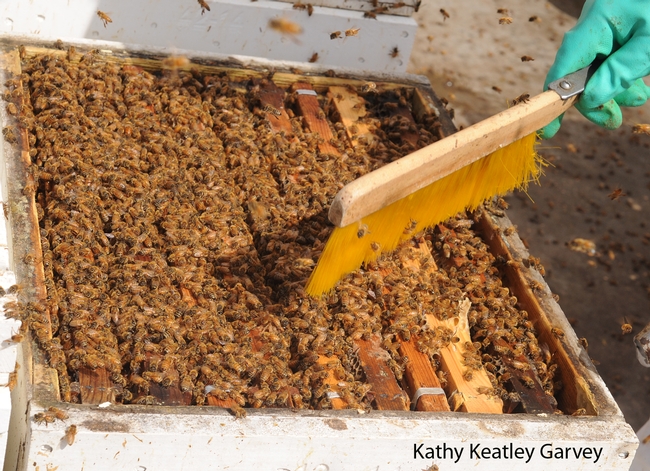
A thriving honey bee colony. (Photo by Kathy Keatley Garvey)
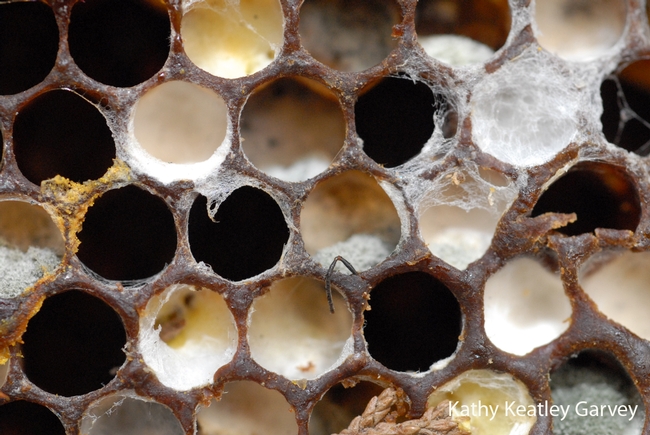
Bees have abandoned the hive in an apparent colony collapse disorder. (Photo by Kathy Keatley Garvey)

